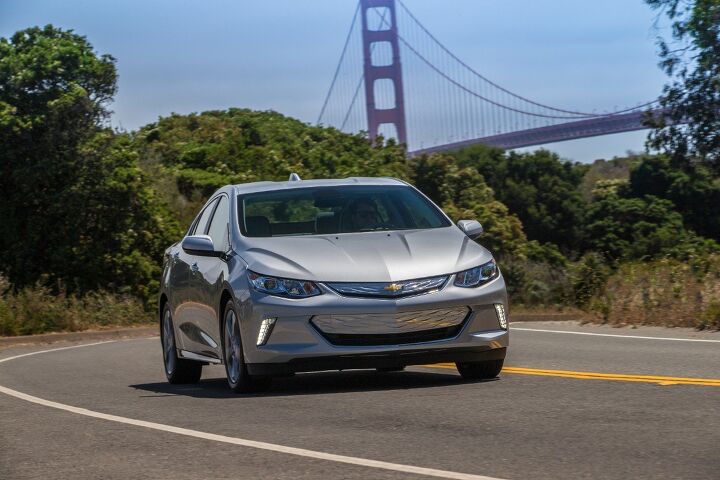2019 Chevrolet Volt: The Overlooked 'Electric' Wants You to Plug In More Often

It’s not a pure EV, but in the early part of this decade, Chevrolet’s Volt offered one of the few mass-produced electric driving experiences on the market. Now in its second generation, GM’s “extended-range electric vehicle” — which packs a 1.5-liter gas generator — has seen its status dwindle as all-electric competitors rivals sprout like dandelions (among them, the confusingly named Chevy Bolt). Lesser plug-in hybrids abound.
Though the Volt still represents an easy-to-live-with compromise between gas-fueled convenience and emission-free commuting, GM knows it needs to do something to sweeten the pot. Extending the range beyond 53 miles seems pointless. But what if the car could charge almost 50 percent faster?
That what General Motors promises for 2019. By adding a 7.2 kilowatt charging system, the 2019 Volt’s charge time drops to 2.3 hours when plugged into a 240-volt hookup — the type you see at public charging stations everywhere.
Depending on your living situation, it might not be all that expensive to install a 240V outlet.
Basically, GM wants to make the Volt a better “electric” car, but without actually adding extra battery capacity. By increasing throughput and decreasing charging times, GM hopes Volt owners decide to make the most of the car’s electric capability, reducing the amount of gasoline used by the inline-four generator. People will be encouraged to top up as they go about their daily grind. It’s also a less-expensive way to boost the appeal of an existing product.
“It effectively extends the vehicle’s all-electric driving range, while providing about twice the range for the money when plugging in at public facilities that charge by the hour,” said Jesse Ortega, chief engineer of Chevrolet’s electric vehicle division, in a statement.
Buyers of the 2019 Volt Premier see this system as standard kit, while Volt LT buyers gain it as an option. The LT comes with a 3.6 kW system.
Other upgrades include new regenerative braking profiles that allow owners to recapture more energy after easing up on the throttle, thus extending the vehicle’s range. Drivers can also defer the startup of the gas generator for cabin heating. If you’re made of tough stuff, GM claims you’ll be able to delay ICE ignition until outside temperatures reach minus 13F (-25C).
For 2019, Volts gain a Chevrolet Infotainment System with 8-inch touchscreen, mated to an energy app that shows users how best to increase their all-electric driving range. Owners can switch between conventional and adaptive cruise, and a digital backup camera replaces the old analog one. The Volt’s low-speed pedestrian warning noise sees a change, too, with look-over-here sounds emitted from front and rear speakers.
Oh, there’s also a power driver’s seat — a feature surprisingly absent from previous versions. Still, the seat only comes standard on Premier trim. LT buyers can spring for one if they want.
After entering the market as a 2011 model, the Volt’s fortunes have waxed and waned. Last year’s U.S. sales tally stands at 20,349 vehicles, but the first quarter of of 2018 showed a marked decrease in volume. We’ll know if that trend continued when GM posts its quarterly sales stats next week.
Expect to see the outwardly unchanged 2019 Volt on dealer lots this fall.
[Images: General Motors]

More by Steph Willems
Latest Car Reviews
Read moreLatest Product Reviews
Read moreRecent Comments
- Jkross22 Ford already has an affordable EV. 2 year old Mach-E's are extraordinarily affordable.
- Lou_BC How does the lower case "armada" differ from the upper case "Armada"?
- TMA1 Question no one asked: "What anonymous blob with ugly wheels will the Chinese market like?"BMW designers: "Here's your new 4-series."see also: Lincoln Nautilus
- Ivor Honda with Toyota engine and powertrain would be the perfect choice..we need to dump the turbos n cut. 😀
- Oberkanone Nissan Titan....RIP



































Comments
Join the conversation
Although i like the looks of the first gen much better(why clone a civic for 2nd gen)This is one of the best cars on the road today. It doesnt get the credit and attention it deserves.
This is a nice update, reflecting the fact that today's Volt buyer is no longer a plug-in hybrid buyer (someone who just wants more MPG) but an EV buyer (someone who wants a pure EV but couldn't find one that met their needs). I can't tell you how many Volt owners I've met who are like me: wanted a Bolt but couldn't bear the Bolt's front seats. That's because Volt is the only PHEV that runs 100% as an electric car until the traction battery is dead. Full throttle? Still an EV. Turn on the heater in all but the most insane weather? Still an EV. Twice as many miles into your drive as any other PHEV can manage on electricity? Still an EV. So for these folks, keeping it EV is important--even though the "generator" is generally inaudible in the Gen 2 Volt. Faster charging makes staying in EV mode possible more of the time. Personally I don't think these changes are what the Volt needs most though. While the faster charging is a neat trick, most Volt owners charge overnight at home anyway, and that's enough time to do the trick even on a wall outlet. And upgrades to the blended braking and infotainment are gilding the lily; they were already best in class. My wish list would be: 1. Wider front seat bottoms without hard plastic sides, 2. Better cabin materials/assembly (no more dashboard buzzes or rear door panels that don't match the fronts), 3. More rear headroom, 4. Quicker steering in Sport mode.